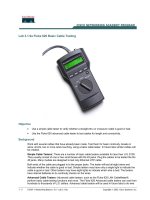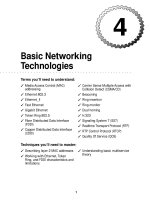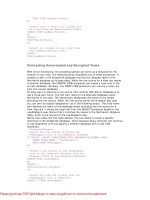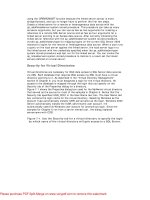MPLS ConceptsIntroducing Basic MPLS Concepts doc
Bạn đang xem bản rút gọn của tài liệu. Xem và tải ngay bản đầy đủ của tài liệu tại đây (1.5 MB, 70 trang )
© 2006 Cisco Systems, Inc. All rights reserved. MPLS v2.2—1-1
MPLS Concepts
Introducing Basic MPLS Concepts
© 2006 Cisco Systems, Inc. All rights reserved. MPLS v2.2—1-2
Outline
• Overview
• What Are the Foundations of Traditional IP Routing?
• Basic MPLS Features
• Benefits of MPLS
• What Are the MPLS Architecture Components?
• What Are LSRs?
• Summary
© 2006 Cisco Systems, Inc. All rights reserved. MPLS v2.2—1-3
Foundations of Traditional IP Routing
• Routing protocols are used to distribute Layer 3
routing information.
• Forwarding decision is made based on:
– Packet header
– Local routing table
• Routing lookups are independently performed at
every hop.
© 2006 Cisco Systems, Inc. All rights reserved. MPLS v2.2—1-4
Traditional IP Routing
• Every router may need full Internet routing
information.
• Destination-based routing lookup is needed on
every hop.
© 2006 Cisco Systems, Inc. All rights reserved. MPLS v2.2—1-5
Basic MPLS Features
• MPLS leverages both IP routing and CEF
switching.
• MPLS is a forwarding mechanism in which packets
are forwarded based on labels.
• MPLS was designed to support multiple Layer 3
protocols
• Typically, MPLS labels correspond to destination
networks (equivalent to traditional IP forwarding).
© 2006 Cisco Systems, Inc. All rights reserved. MPLS v2.2—1-6
MPLS Architecture: Control Plane
© 2006 Cisco Systems, Inc. All rights reserved. MPLS v2.2—1-7
MPLS Architecture: Data Plane
© 2006 Cisco Systems, Inc. All rights reserved. MPLS v2.2—1-8
MPLS Devices: LSRs
• The LSR forwards labeled packets in the MPLS domain.
• The edge LSR forwards labeled packets in the MPLS domain,
and it forwards IP packets into and out of the MPLS domain.
© 2006 Cisco Systems, Inc. All rights reserved. MPLS v2.2—1-9
Label Switch Routers:
Architecture of LSRs
© 2006 Cisco Systems, Inc. All rights reserved. MPLS v2.2—1-10
LSR Architecture Example
MPLS router functionality is divided into two major
parts: the control plane and the data plane.
© 2006 Cisco Systems, Inc. All rights reserved. MPLS v2.2—1-11
LSRs:
Architecture of Edge LSRs
© 2006 Cisco Systems, Inc. All rights reserved. MPLS v2.2—1-12
Basic MPLS Example
• MPLS core routers swap labels and forward packets based on simple
label lookups.
• MPLS edge routers also perform a routing table lookup, and add or
remove labels.
© 2006 Cisco Systems, Inc. All rights reserved. MPLS v2.2—1-13
MPLS Labels
• Are 4 byte identifiers used for forwarding
decisions
• Define the destination and services for a packet
• Identify a forwarding equivalence class (FEC)
• Have local significance
– Each LSR independently maps a label to an FEC
in a label binding.
– Label bindings are exchanged between LSRs.
© 2006 Cisco Systems, Inc. All rights reserved. MPLS v2.2—1-14
MPLS Labels: Frame-Mode MPLS
© 2006 Cisco Systems, Inc. All rights reserved. MPLS v2.2—1-15
MPLS Label Operations: Frame Mode
•
On ingress, a label is assigned and imposed.
•
LSRs in the core swap labels based on the contents of the label forwarding table.
•
On egress, the label is removed and a routing lookup is used to forward the packet.
© 2006 Cisco Systems, Inc. All rights reserved. MPLS v2.2—1-16
MPLS Unicast IP Routing
Architecture (Cont.)
© 2006 Cisco Systems, Inc. All rights reserved. MPLS v2.2—1-17
MPLS Unicast IP Routing
Architecture (Cont.)
© 2006 Cisco Systems, Inc. All rights reserved. MPLS v2.2—1-18
MPLS Unicast IP Routing
Architecture (Cont.)
© 2006 Cisco Systems, Inc. All rights reserved. MPLS v2.2—1-19
LSP Building
The IP routing protocol determines the path.
© 2006 Cisco Systems, Inc. All rights reserved. MPLS v2.2—1-20
LSP Building (Cont.)
LDP propagates labels to convert the path to an LSP.
© 2006 Cisco Systems, Inc. All rights reserved. MPLS v2.2—1-21
PHP: Before
• Double lookup is not an optimal way of
forwarding labeled packets.
• A label can be removed one
hop earlier.
© 2006 Cisco Systems, Inc. All rights reserved. MPLS v2.2—1-22
PHP: After
A label is removed on the router before the last
hop within an MPLS domain.
© 2006 Cisco Systems, Inc. All rights reserved. MPLS v2.2—1-23
Label Distribution and Advertisement
The allocated label is advertised to all neighbor LSRs, regardless
of whether the neighbors are upstream or downstream LSRs for
the destination.
© 2006 Cisco Systems, Inc. All rights reserved. MPLS v2.2—1-24
Label Distribution and Advertisement:
Receiving Label Advertisement
• Every LSR stores the received label in its LIB.
• Edge LSRs that receive the label from their
next hop also store the label information in
the FIB.
© 2006 Cisco Systems, Inc. All rights reserved. MPLS v2.2—1-25
Label Distribution and Advertisement:
Interim Packet Propagation
Forwarded IP packets are labeled only on the path segments
where the labels have already been assigned.









